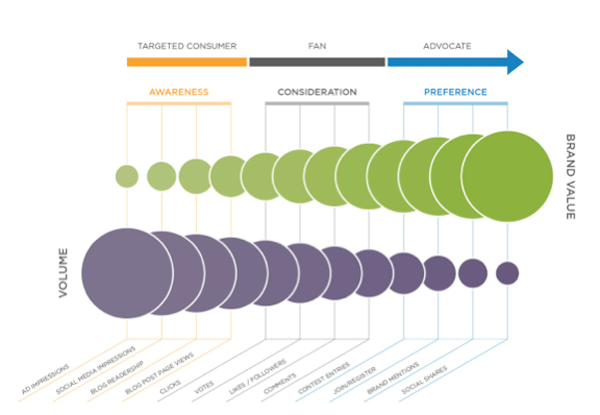Social Behaviors That Drive Brand Advocacy
Transforming a target consumer into a brand advocate is one of the best goals a brand can have for their online marketing campaign, but the digital landscape can be challenging. Digital marketing spends have increased, but the industry has not necessarily been met with a rise in ROI confidence. When currency is measured in behavior, how do you know which actions reflect a true path to consumer conversion?
The explosion of content marketing in recent years reflects a critical need from marketers to engage with consumers in a way that actually changes buyer behavior. Adults spend 11 hours per day engaged with digital media (Mashable 2014), and digital marketing is projected to make up 25% of most brands marketing budgets in 2015 (Gartner 2014). The digital landscape has never been so important to building brands and converting web users to purchasers.
Yet, yesterday’s digital marketing solutions such as banner and search advertising and even newer methods like mentions and targeted ads on social media networks are proving frustrating. These marketing methods aren’t driving the online consumer behaviors that convert to purchase and brand advocacy—the Holy Grail for all brand marketers.
While conversational marketing and integrating social engagement with content creation may not produce the volume that online advertising does, these actions create value—which is the key to developing brand loyalists. But if prompting these actions were easy, everyone would be doing it.
Not all online consumer behaviors are created equal. In fact, the value of an online behavior can be inversely proportional to the volume of the behavior. While a behavior such as an impression (available in volume simply by spending money) may raise awareness, and a click might take the consumer further along to preference, these behaviors on their own do not result in the most valuable acts of purchase and brand evangelism.
In the hierarchy of digital consumer behavior, content creation and social engagement are proving to be pivotal strategies for transforming consumers into brand advocates. Yet, these behaviors are also hardest for marketers to generate. So let us break it down….
 The Path to Transforming a Consumer
The Path to Transforming a Consumer
Awareness
Consumers are either consciously or unconsciously ignoring information presented in banner and display ads, according to web usability studies. Consumers are tuning them out, especially those display ads that take them further away from the actual task at hand on a web page, i.e. clicking an important link or filling out a form. Eighty-two percent of Americans ignore online display/banner ads completely. But the value of an impression goes up significantly when it’s an impression of content created by a peer or influencer. These include social media impressions from blogs, Facebook, Twitter, Pinterest and other social platforms. Impressions are great but you can’t stop there.
Benefits Getting online impressions is a volume game that can be bought. And for a brand launching a new product, new flavor, or targeting a new customer demographic, generating impressions is key.
Drawbacks Impressions can be measured but there’s no way to measure sentiment. Impressions don’t usually translate directly to purchase but they are the first necessary step. High volume, low value.
Consideration
Once consumers know a product or brand exists, the next goal is to get them to consider the product. Consideration when a consumer is entertaining the thought of purchasing. They are weighing the benefits, comparing brands, asking for opinions from others, and looking more closely at details. It is common in this phase for consumers to want opinions from others who most closely match their own needs. A person who runs marathons considering a new pair of running shoes is not going to ask a tennis player what he bought – he’s going to ask the opinion of other long-distance runners. These social behaviors include liking, pinning, collecting, voting or ranking, watching a video, or taking action that engages with content in some way.
Benefits More action equals more commitment and builds community. When consumers take a simple action, they have moved from awareness to consideration, an important step in prompting a purchase and creating a brand advocate. Three quarters of consumers consult social media when actively or passively considering a purchase. Typically results in medium volume with medium value.
Drawbacks Too many choices. Is it better to gain a Facebook like, a Twitter follower, a view of your video, or entering a contest? There isn’t enough evidence to suggest that brands should ignore one social network in favor of another. All social media seem to matter in influencing consumer decisions.
Preference
If a consumer is taking actions comparing one brand to another or one flavor or size to another, the next conversion point is when they start indicating a preference. Instead of weighing opinions and experiences equally among their influencers, the start expressing opinions of their own, perhaps about price, style, color, or model and trying to get closer to the product. These behaviors include joining contest to possibly win the product, watching a movie trailer, sharing content, mentioning brands by name, and even creating their own content about the brand.
Benefits Preference behavior sends intent-to-buy signals, which is the highest value behavior a brand can drive from a consumer (other than purchase)
Drawbacks Creating content isn’t always what brands do best. Content needs to be value-based, authentic, and be focused on the needs of the consumer, not the brand. Biggest challenge is creating the volume of high-value, high-quality content required to get consumers to take action.
The key is to be mindfully creating content for all three phases of the buyer journey, measuring how consumers convert from one phase to another, and getting feedback about what worked and what didn’t. Mapping social content to the consumer buying journey is not an exact science but it can be optimized for the highest value.— Holly Hamann is co-founder and CMO of TapInfluence. You can follow Holly at @HollyHamann.






























